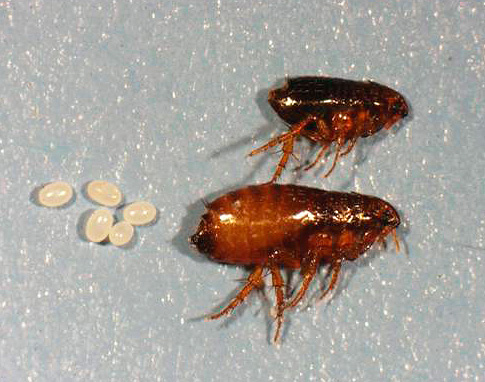
Fleas are parasites without a particularly narrow specialization in terms of choosing their prey. They bite humans in the same way as other animals, although most flea species still prefer to bite their natural hosts.
For example, for a dog flea, it is the dog and animal species close to dogs - foxes and wolves - that are most suitable. And fleas in people appear when it is the bipedal host that is near the hungry insect.
Few people know, but there is a real human flea. The one for which the main and most preferred source of food is precisely a person. This insect differs quite a bit in appearance and way of life from its relatives, but, like other jumping parasites, it does not constantly live on a person.
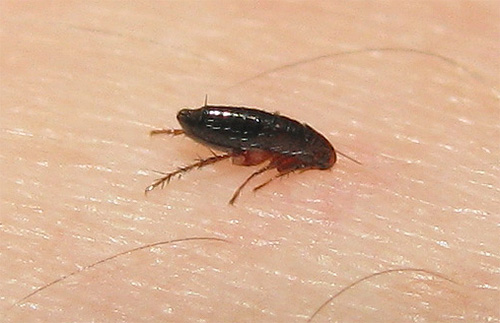

It is interesting
A common misconception: some people think that fleas live on humans or animals all the time. In fact, this is not so. The life cycle of a flea does not imply its permanent residence on the body of the host, and flea larvae do not generally develop on the surface of the body of warm-blooded animals.
The human flea and its bites: a detailed description
Human fleas are quite large compared to their relatives (other types of fleas).The body length of an adult insect is about 3 mm. With such dimensions, the parasite can jump up to half a meter in length.
The photos below show adult human fleas: we can clearly distinguish the dark brown color of their body and it is clear that they do not have wings.

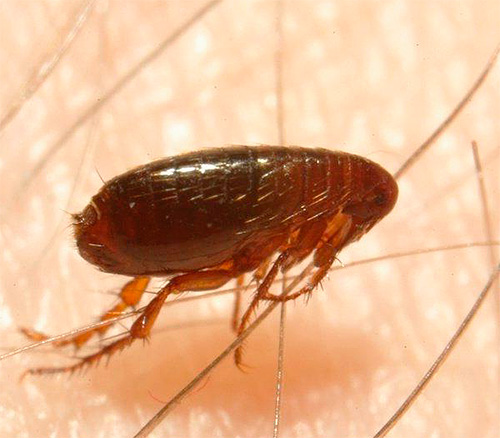
They differ from other human parasites in their laterally flattened body: this shape helps them to move easily among the hairs in the head and not be crushed when catching or scratching bites.
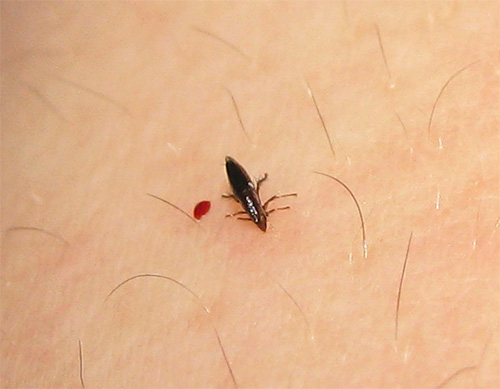
On a note
Lice and fleas in humans are often found in similar places - where the body is covered with hair. But at the same time, lice are very inactive and sit mainly on the hair, and fleas are almost elusive and move precisely along the skin.
Human fleas can hardly be distinguished from dog or cat fleas with the naked eye. Only an entomologist can distinguish one species from another by an enlarged photo or under a microscope.
At first glance, human fleas look like small brown grains on the body or on the floor. Insects in them are given out by movement. A person is not able to see a flea at the moment of a jump: the glance only notices an insect present in one place and in the next moment - its disappearance.

It is interesting
The appearance of human fleas was studied in detail in the Middle Ages. There are numerous pictures depicting these insects, mentioning them in the writings of scientists. Like bedbugs, these parasites disturbed a person especially strongly, and therefore attracted close attention at all times.
Flea larvae are often confused by ignorant people with fly larvae. They are very small - a few millimeters in length - white, have a worm-like body and live mainly in heaps of organic debris.

The photo below shows a flea larva at multiple magnification:

Adult fleas feed exclusively on the blood of warm-blooded animals. There are only a few species of these parasites that can eat and blood of reptiles. The main host of the human flea is a person, but in the absence of it, it successfully attacks dogs and cats.
The photo shows a feeding insect: due to the lack of a special proboscis, she is forced to immerse her head deep into the integument of the host's body:
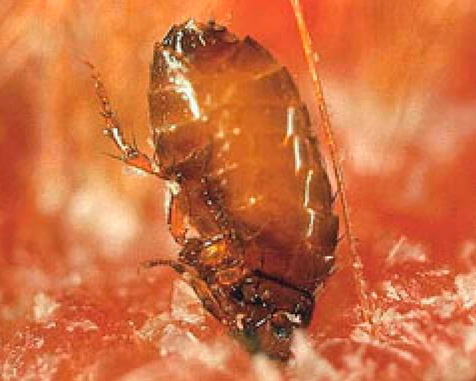
An adult insect spends most of its life in secluded places located as close as possible to places of constant human presence. Here the parasites multiply, and here their larvae develop, feeding either on decaying organic remains or on the excrement of adult fleas.
Becoming hungry, fleas jump on people or animals that have appeared nearby, pierce the skin and suck blood from a blood vessel. After saturation, the parasite immediately tries to leave the host's body. In fact, these insects do not live on the human body (unlike, for example, lice), and the expression “people have fleas” and the question “do people have fleas?” not quite correct.


It is interesting
From an evolutionary point of view, fleas as parasites are of great interest to scientists. If other parasites such as bedbugs have learned to make their bites painless due to special enzymes, then fleas do not “worry” about this: their injections are very, very sensitive. On the other hand, a person cannot crush even a well-fed flea with his fingers: here natural selection has already helped the parasites become less vulnerable due to the loss of wings and flattening of the body.
An adult flea lives on average for several months, although theoretically it can live up to a year and a half. According to scientists, in its lifetime one insect can become a parent for 500 direct descendants and more than several tens of thousands - "grandchildren" and "great-grandchildren".
It is interesting
Judging by the paleological data, before the appearance of man on the planet, human fleas lived on the territory of modern South America and parasitized on local pigs and large rodents.
The human flea is very similar to its other relatives in its versatility: it can attack many warm-blooded animals. As well as other types of these parasites, they calmly jump onto a person. Therefore, having met a flea on your body, you can never unequivocally say that this is a human flea.
What other fleas attack people
In addition to the human flea, more than 1,500 species of these parasites can potentially attack humans - almost all of those that are not rigidly tied to specific species of mammals and birds.
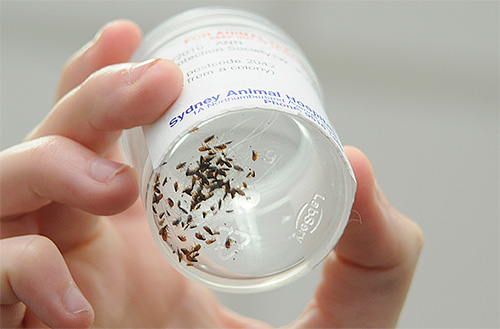
The following types of fleas most often bite a person:
- feline - the most common
- canine
- rats (carriers of the plague during the Middle Ages)
- rabbits, attacking most often in the wild.
At the same time, all these insects jump on people when their usual owners are not around. For example, rabbit fleas most often bite hunters who find themselves near holes in a rabbit colony.
On a note
Hunters sometimes say that they were bitten by earthen fleas. In fact, earthen fleas do not bite a person: not even fleas are called that, but small herbivorous beetles that harm fields and gardens. Hunters are usually bitten by fleas from fox or rabbit holes.
The most painful bites for humans are caused by fleas that parasitize large herbivores. According to the testimonies of the victims, the bites of large - up to 5 mm - moose fleas are more painful than even bee stings.
Why are fleas dangerous for humans?
The most common consequence of flea bites is pulicosis - a set of symptoms resembling allergies:
- profuse continuous rashes in the area of bites
- inflammation of the bites themselves, sometimes suppuration
- sores in the mouth and throat
- swollen lymph nodes
- increase in body temperature
- headaches, irritability, insomnia.

But fleas are much more dangerous for people because they are potential carriers of helminths and pathogens of the following diseases: plague, anthrax, encephalitis, trypanosomiasis. Scientists have found more than 200 viruses, bacteria and protozoa in the organisms of different types of these parasites that can cause deadly human diseases.
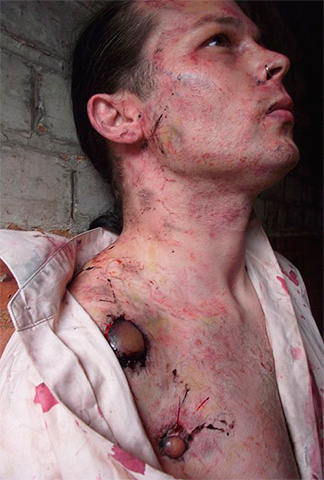
Of course, not every flea bite will reward you with such a disease. But you should always be aware of the potential danger of such bites.
Flea Remedies
The fight against fleas is always getting rid of them in an apartment or house. There is no point in catching and destroying parasites on yourself, this will not help.
There are many ways to get rid of human fleas in an apartment:
- pickle the room with a special insecticidal aerosol. Raptor, Raid, Combat aerosols, as well as the Executioner insect repellent, have proven themselves well in this regard.

- Use insecticidal contact powders. They will also help get rid of flea larvae.

- Or call a team to destroy parasites - this is the most reliable, but also expensive way to get rid of fleas.

Separately, it should be said about flea larvae. For their destruction, special dusts are well suited, which are used to remove cockroaches (for example, Clean House dust, Feverfew powder and others).
After ridding the home of insects, it is important to maintain cleanliness in the room and observe preventive measures against the penetration of parasites into it.
Treatment of human flea bites consists in treating the bite sites with antiseptic soap and alcohol solutions - brilliant green or iodine. With the development of pulicosis or allergies, only a doctor can prescribe medications for the treatment of bites. These may include antihistamines, sedatives, and medications for symptomatic treatment.
On a note
There is no specific flea shampoo for humans. Insecticidal shampoos for pets are produced for the reason that insects can survive in their thick coat even after bathing.
But protection from parasites in the field is necessary. To do this, you can use popular insect sprays. A good flea spray for humans should definitely contain enough DEET, a powerful insect repellant.

Among the most popular sprays that can repel fleas are the following:
- Off-Extreme, a well-known remedy for mosquitoes and mosquitoes
- Biban is a reliable remedy for almost all blood-sucking insects
- Gall Rat
- Gardex, which has proven itself in tests in the northern taiga.
On a note
Flea sprays are more effective than ointments.Due to their mobility, fleas can jump on different areas of the skin, which are easier to treat with a spray than with ointments or gels.
And, of course, banal foresight will help to protect against fleas. Do not stroke dirty stray animals, visit premises that do not meet sanitary standards less often, and have long-sleeved clothes with you when going out into the countryside - all this will be enough to protect yourself from bloodsuckers.
Useful video: how to get rid of fleas in the apartment



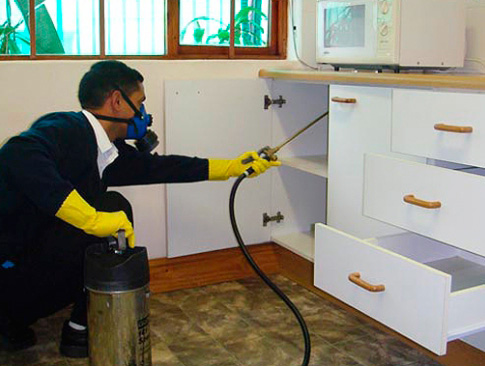
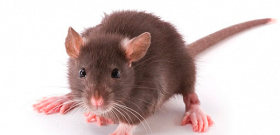

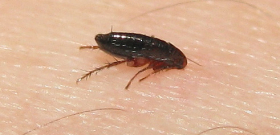
For some reason, I used to think that fleas don't bite people. And here it is, as it turns out. Good article!
And we poisoned seven times - with Katrin, and Medilis Ziper, and Sinuzan, and Yurex, and a paragraph, and ... But nothing takes them. They were brought to our house by Tajiks in a neighboring apartment, now three recreation areas are infected. How to be?..
Wash your floor with amway loc. We and our friends so bring both from the floor and from cats and dogs.I don't know what it contains, but they die from it.
Thanks for the article, I learned a lot.
Damn, I read it. Now my head is itching 😀
As always.
I don’t even know who bit me)) The first night they bit my whole neck, and today my whole leg.